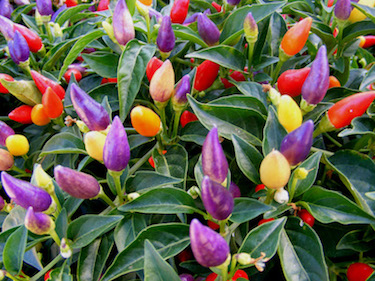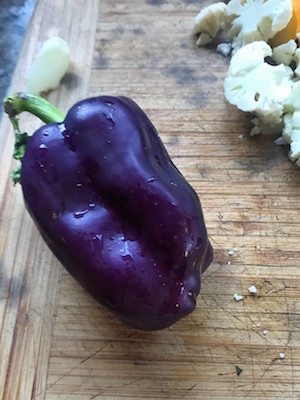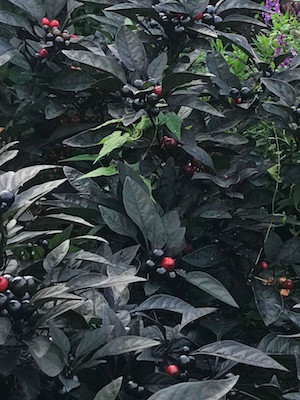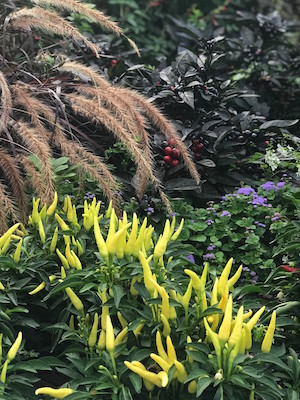Southwest Yard & Garden by Dr. Marisa Thompson
 . This ornamental 'NuMex Twilight' chile plant produces colorful fruit all season long (photo credit The Chile Pepper Institute).
. This ornamental 'NuMex Twilight' chile plant produces colorful fruit all season long (photo credit The Chile Pepper Institute).
Question: What’s the difference between different colors on peppers? I’m getting red fruit and purple fruit on the same plant.
Mary S., Santa Fe, NM
Answer: The diverse colors on peppers are indicators that they are rich in phytochemicals, whether they be sweet, hot, or sweet and  High levels of anthocyanin pigments make this bell pepper dark purple (photo credit Mary S.)hot. Three main classes of phytochemicals are responsible for these pretty pigments. Chlorophyll is commonly associated with greenness. Carotenoids are the phytochemicals causing the colors to get warmer as they turn from yellow to orange to red. And anthocyanins create those dynamic purple and blackish colors.
High levels of anthocyanin pigments make this bell pepper dark purple (photo credit Mary S.)hot. Three main classes of phytochemicals are responsible for these pretty pigments. Chlorophyll is commonly associated with greenness. Carotenoids are the phytochemicals causing the colors to get warmer as they turn from yellow to orange to red. And anthocyanins create those dynamic purple and blackish colors.
The relative concentrations of these phytochemicals as they accumulate in the fruit tissue dictates the color. These pigment chemicals also affect the nutrient content, level of spiciness, and use as natural dyes.
Originating in the Americas, the Capsicum genus includes all peppers. The species Capsicum annuum includes the bells, cayenne, New Mexico green and red chiles, and jalopeños, among others.
In a 2011 textbook entitled “The Biological Activity of Phytochemicals,” assistant professor of horticulture at NMSU, Dr. Ivette Guzman, along with Drs. Bosland and O’Connell, explained these different pepper phytochemicals in the chapter, “Heat, color, and flavor compounds in Capsicum fruit.” I’ve included some of that text in this column. For the whole chapter and links to other info about pepper color, visit www.nmsudesertblooms.blogspot.com.
“These molecules absorb light at different wavelengths and aid in the conversion of light energy into chemical bond energy during photosynthesis. Pigments act as ultraviolet and visible light protectants in plant tissues and can have additional antioxidant properties. Not only do pigments function at a cellular level, they also function as attractants for pollinators and seed dispersal agents."
Chlorophyll
“In pepper, unripe fruit colors can vary from ivory, green, or yellow. The green color is accumulation of chlorophyll in the chloroplast while ivory indicates chlorophyll degradation as the fruit ripens. The persistent presence of chlorophyll in fruit ripening to accumulate other pigments like carotenoids or anthocyanins produces brown or black mature fruit colors. Chlorophyll in black pepper fruit is 14-fold higher compared to purple fruit."
Carotenoids
“Yellow, orange and red color in mature pepper fruits is a result of carotenoid metabolism and accumulation in the chromoplasts of the pericarp or fruit wall. Carotenoids are the largest group of natural plant pigments. Carotenoids help in photosynthesis as light harvesting pigments given that they absorb at different wavelengths than chlorophyll. They also protect the photosynthetic centers from photooxidative damage by acting as quenchers of triplet excited states in chlorophyll molecules.
“During fruit ripening, the pepper carotenoid biosynthetic pathway is able to make a variety of carotenoids including β -carotene, lutein, violaxanthin, capsorubin, and capsanthin. The latter two are specific to peppers and are not found in other plants. Capsanthin and capsorubin accumulate in red colored peppers, while β -carotene is responsible for orange colored fruit.
“Beta-carotene rich peppers are important sources of vitamin A, with some varieties accumulating 136 μg of β -carotene per gram fresh weight. Carotenoids are so important that the USDA recommends incorporating orange fruits or vegetables twice a week in a diet. Red and orange peppers, especially, have a high content of carotenoids. Pepper breeders are interested in making carotenoid-rich peppers not only for higher vitamin A content but also for use in red pigment extraction. The red pigments are extracted as an oleoresin and used as a natural colorant. This dye is used in a variety of products ranging from cosmetics to food coloring."
Anthocyanins
“In some peppers, immature pepper fruit and leaves can appear violet to black in color. These colors are attributed to anthocyanin accumulation in the vacuoles. Anthocyanins are flavonoids synthesized from the phenylpropanoid pathway. Black or violet peppers metabolize and accumulate anthocyanins like delphinidin as both an aglycone and glycosylated compound (Lightbourn et al. 2008).
“The intense black pigmentation in pepper leaves and fruit is characteristic of high concentrations of delphinidin, chlorophyll and carotenoids, with the leaves accumulating 7-fold higher levels of delphinidin than the fruit. Other than delphinidin, there are no other anthocyanins known to accumulate in peppers.”
So, now we know the difference between red and green chiles is just the relative amounts of these phytochemicals at different points of maturity. Instead of “red or green” we could be asking “chlorophyll or carotenoids?”
Researchers at the Chile Pepper Institute at NMSU’s main campus in Las Cruces have breeding programs that focus on developing new chile cultivars in addition to preserving older breeding lines (www.cpi.nmsu.edu). The ornamental chile cultivars are stunning for their bright colors and funny fruit shapes. They make beautiful seasonal décor as houseplants and can also be added to flowerbeds for annual color. I recently saw several in landscape gardens and flower boxes in Washington, D.C. I taste tested one almost-black pepper the size and shape of a marble. The flavor was almost nonexistent, but the heat was intense and immediate. Right away in reaction to the spicy heat, my left eye started watering and I got hiccups. Just because a fruit is edible, doesn’t mean you want it smothered on your enchiladas!
 Ornamental chile plants with deep purple, almost-black fruit and leaves decorate flowerbeds in Washington, D.C. (photo credit T. van der Ploeg).
Ornamental chile plants with deep purple, almost-black fruit and leaves decorate flowerbeds in Washington, D.C. (photo credit T. van der Ploeg). Two cultivars of ornamental chiles beautify this Washington, D.C. flowerbed (photo credit T. van der Ploeg).
Two cultivars of ornamental chiles beautify this Washington, D.C. flowerbed (photo credit T. van der Ploeg).
Send gardening questions to Southwest Yard and Garden - Attn: Dr. Marisa Thompson at desertblooms@nmsu.edu.
Please copy your County Extension Agent and indicate your county of residence when you submit your question!
For more gardening information, visit the NMSU Extension Horticulture page at Desert Blooms and the NMSU Horticulture Publications page at NMSU Horticulture Publications page.
Marisa Y. Thompson, PhD, is the Extension Horticulture Specialist, in the Department of Extension Plant Sciences at the New Mexico State University Los Lunas Agricultural Science Center, office: 505- 865-7340, ext. 113.


